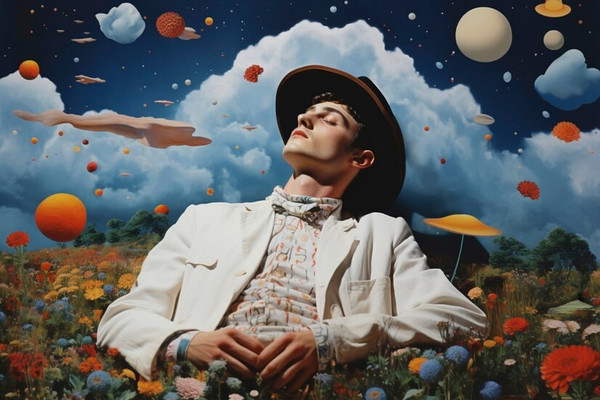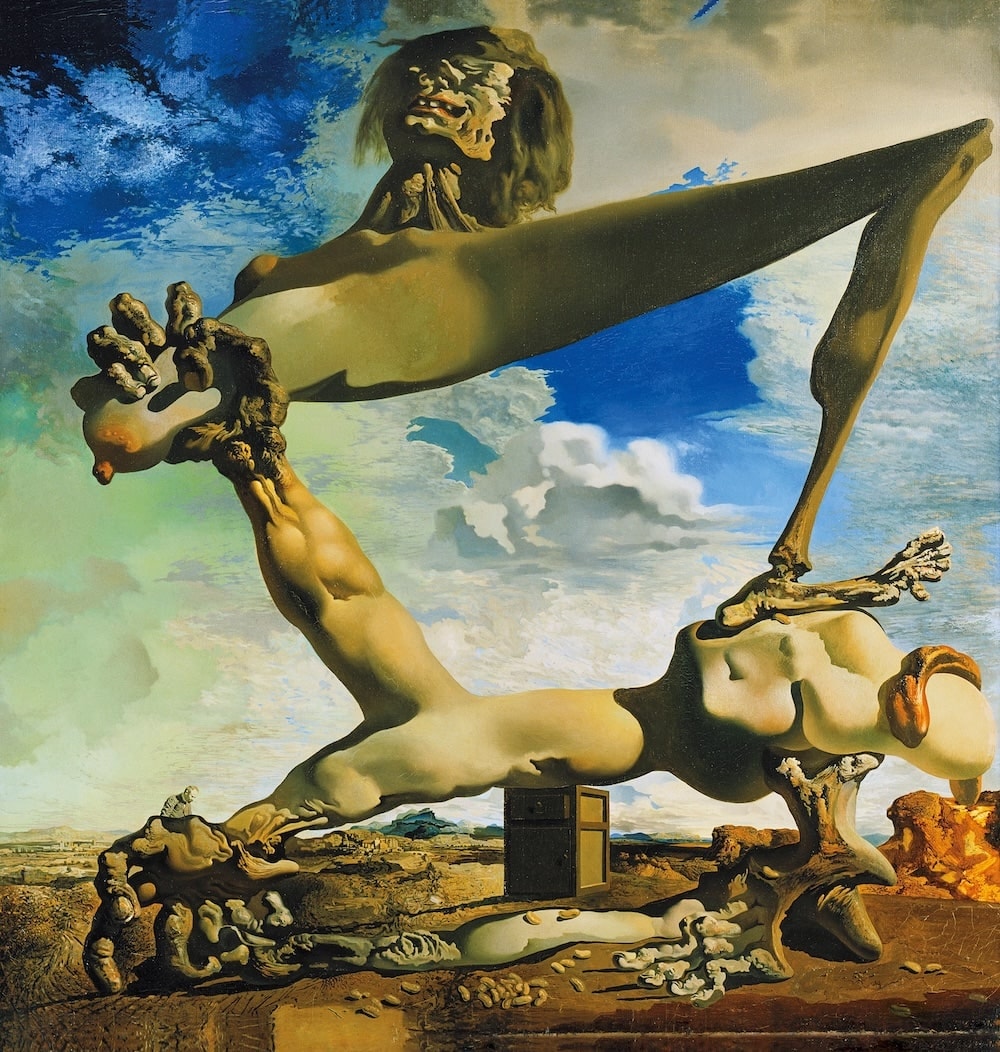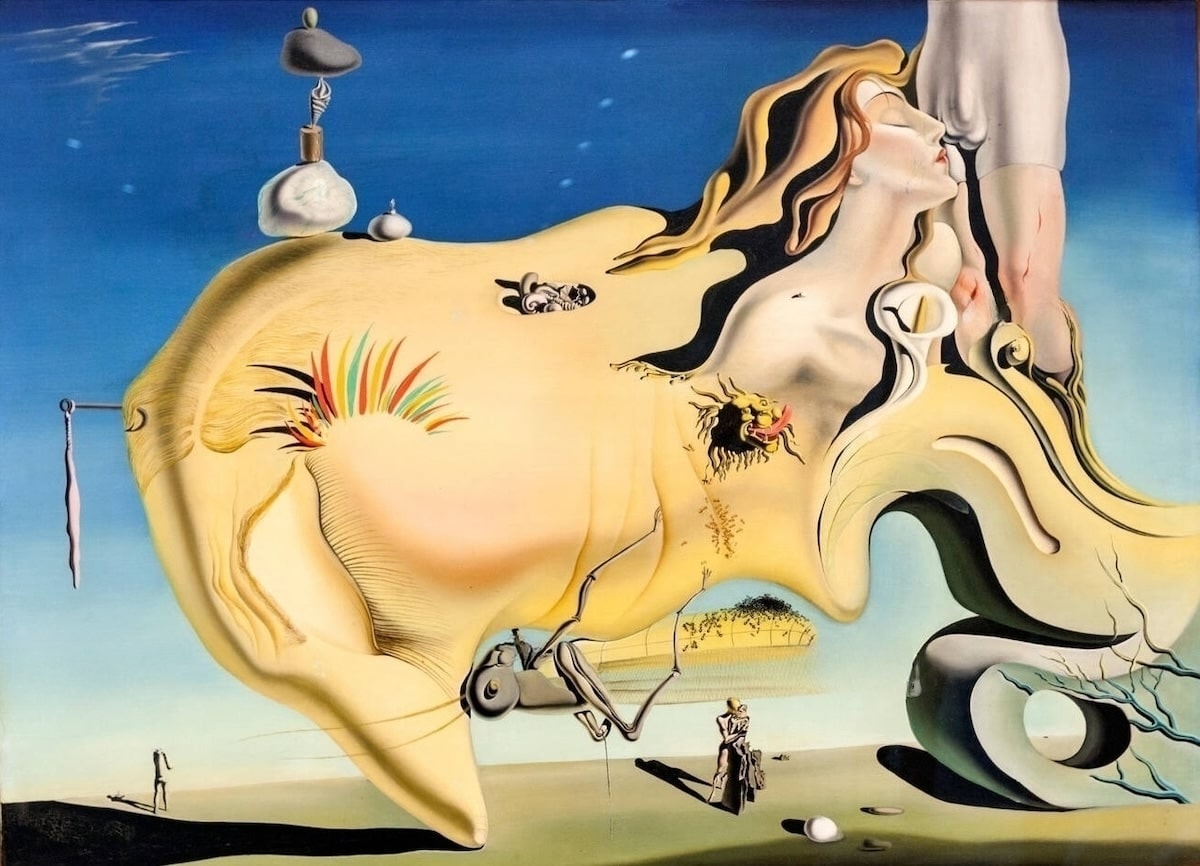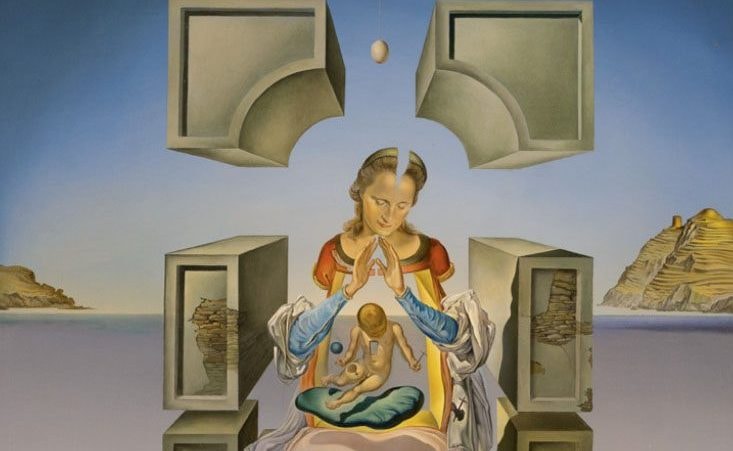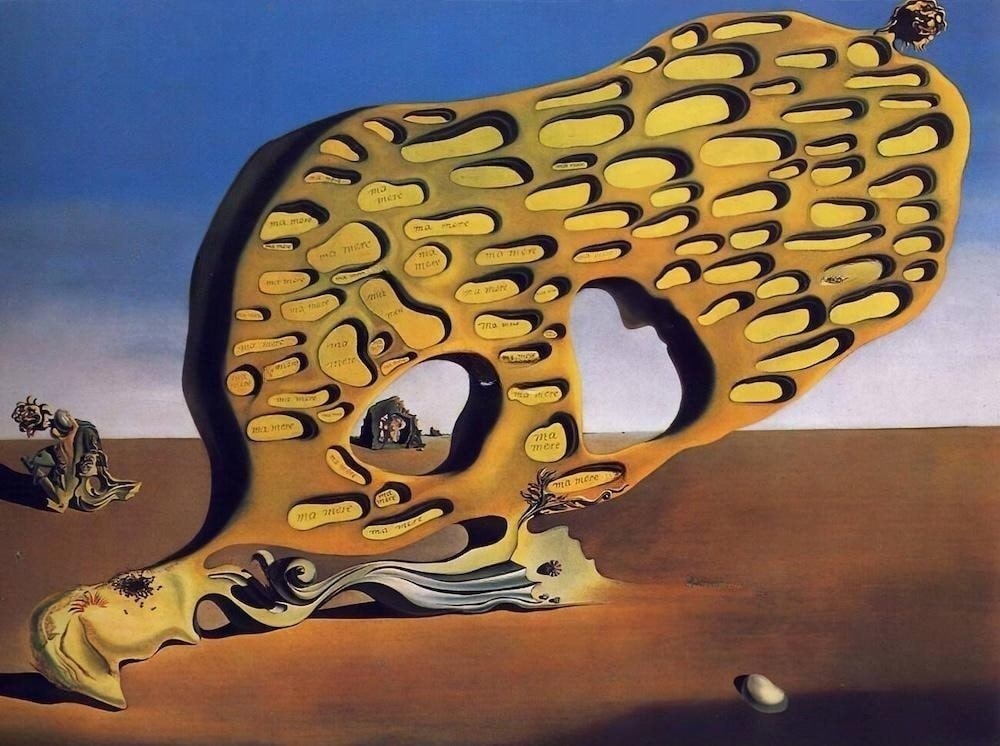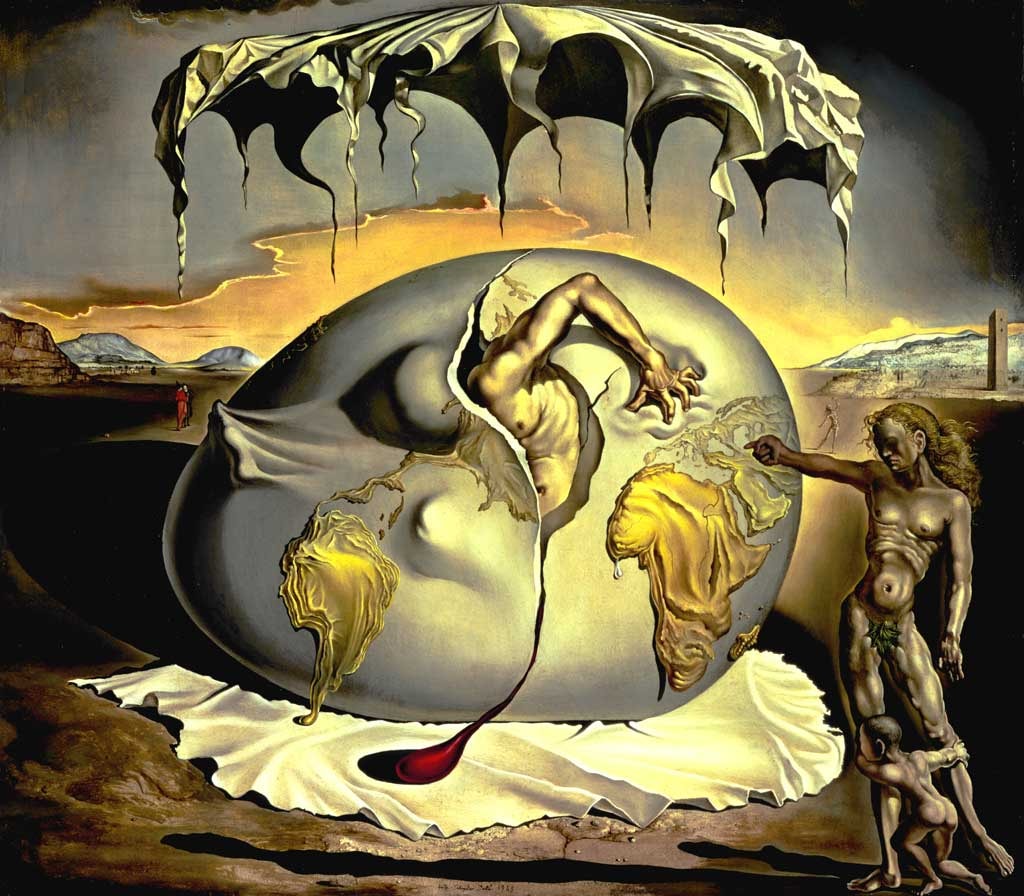25 Salvador Dali Famous Paintings and Their Hidden Meanings
Posted by MintSuper Art on 13th Jan 2025
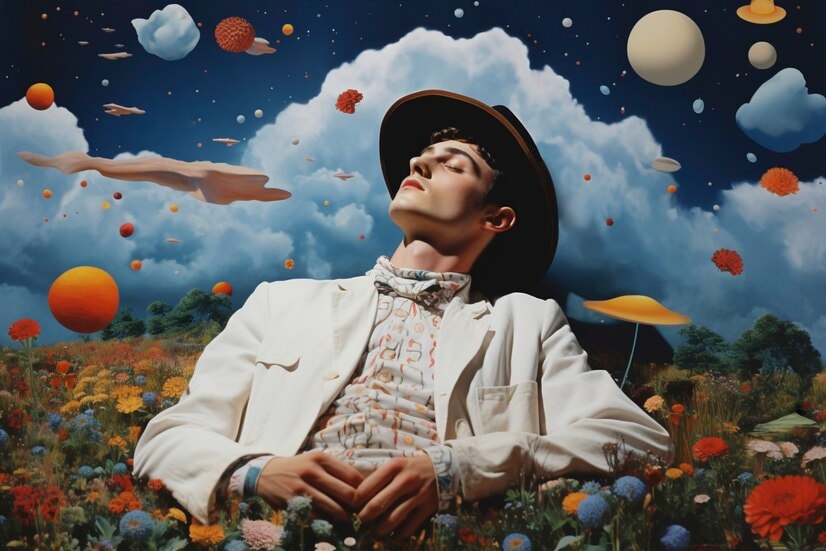
Salvador Dalí, one of the most renowned and eccentric figures in art history, was a Spanish surrealist painter celebrated for his striking and dreamlike creations. Born in 1904 in Figueres, Catalonia, Dalí's artistic genius and flamboyant personality propelled him to international fame. As a leading figure of the surrealist movement, his works are characterized by bizarre imagery, meticulous detail, and deep symbolic meaning. Dalí’s innovative approach to exploring the subconscious, dreams, and the human psyche has left a lasting impact on modern art. Dalí died of heart failure on January 23, 1989, in Figueres, Spain.
Beyond his artistry, Dalí’s influence extends into literature, film, and even fashion, making him one of the most versatile and enigmatic figures of the 20th century. His most famous surrealist paintings, such as The Persistence of Memory and The Elephants, continue to captivate audiences worldwide, offering profound insight into the surreal and symbolic dimensions of the human experience.
Salvador Dali Famous Paintings You Need to Know
Salvador Dalí's artistic legacy is defined by a collection of masterpieces that push the boundaries of imagination and creativity. Each of his most famous paintings is a window into his complex mind, filled with symbolism and surrealist imagery that invites interpretation. The following works represent Dalí's most celebrated art contributions, each with a unique story and meaning waiting to be uncovered.
1. The Persistence of Memory (1931)
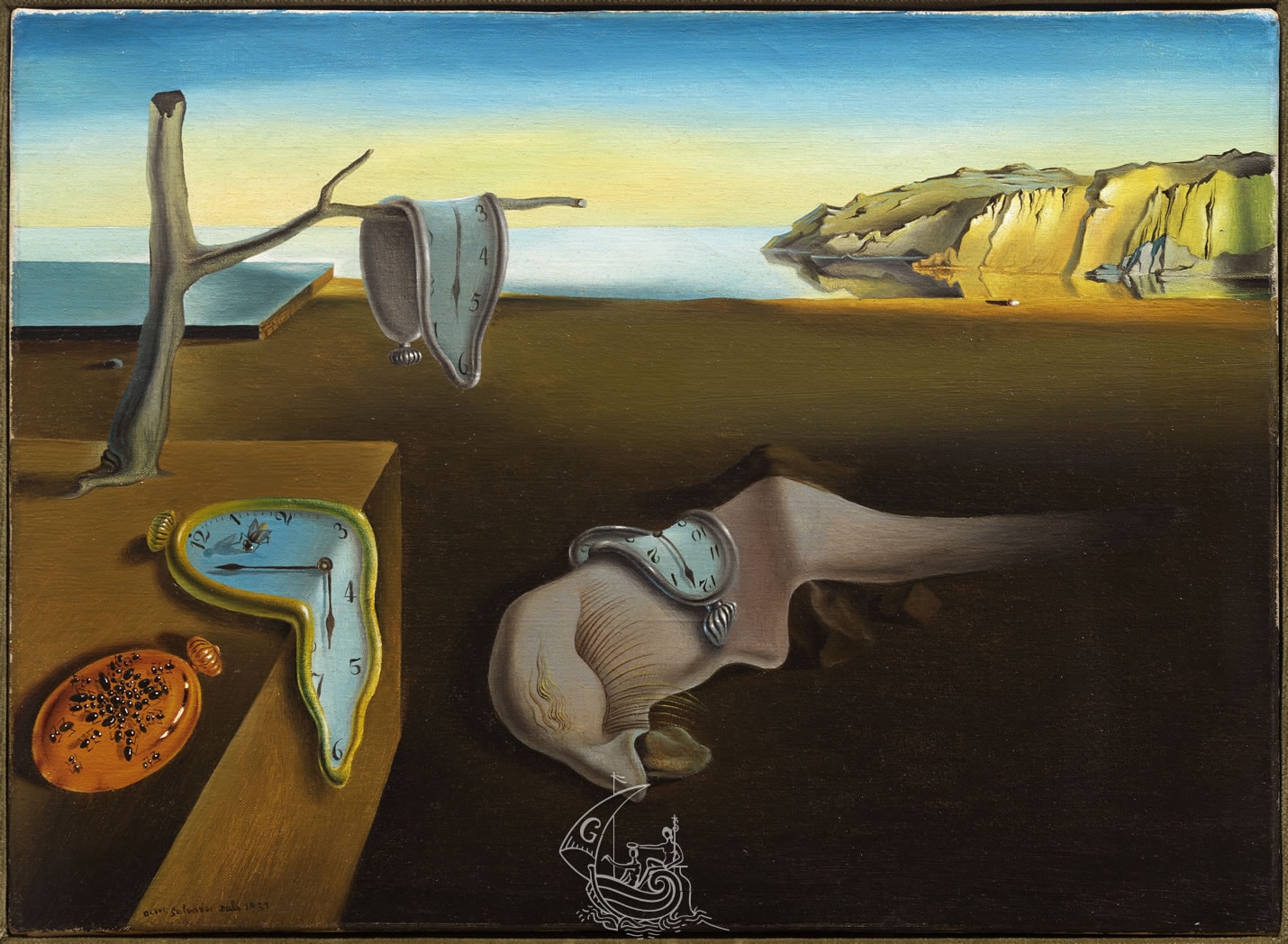
This painting, with its melting clocks draped over a barren landscape, is arguably Dalí's most famous work. Often interpreted as a meditation on the fluidity of time, it challenges the rigidity of traditional perceptions of chronology. The soft clocks symbolize the impermanence of human constructs, while the eerie, dreamlike setting invites viewers to question reality. The piece is a hallmark of Dalí’s exploration of the subconscious and the surreal. This paintings is housed at Museum of Modern Art (MoMA), New York City, USA
2. The Elephants (1948)
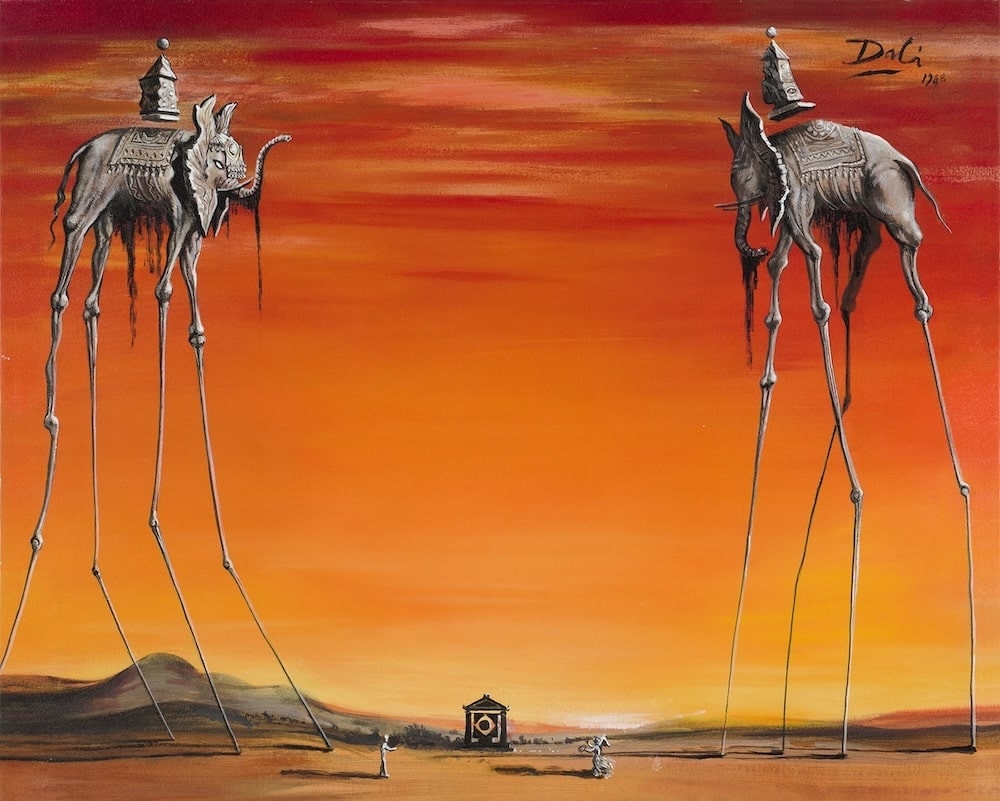
In The Elephants, Dalí portrays these majestic creatures with impossibly long, spindly legs, bearing towering obelisks. The elephants symbolize strength and power, while their fragile forms evoke a sense of imbalance. Inspired by Gian Lorenzo Bernini's sculptures in Rome, the obelisks signify burden and eternity. This surreal depiction captures Dalí’s ability to juxtapose opposites, making it one of his most iconic works.
3. The Burning Giraffe (1937)
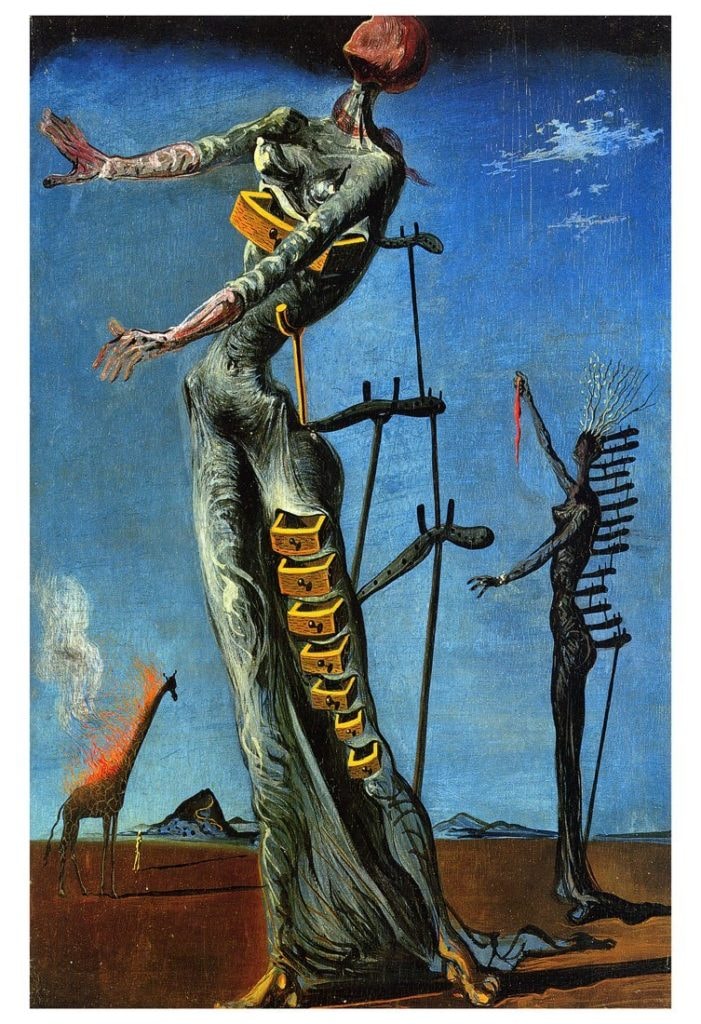
A haunting premonition of war, The Burning Giraffe captures the anxiety and turmoil of the late 1930s. The central figure, a skeletal form with open drawers protruding from its body, symbolizes the human psyche laid bare. The burning giraffe in the background serves as a beacon of destruction and chaos, reinforcing Dalí's fears about the future of humanity.
Location: Kunstmuseum Basel, Basel, Switzerland
4. Swans Reflecting Elephants (1937)
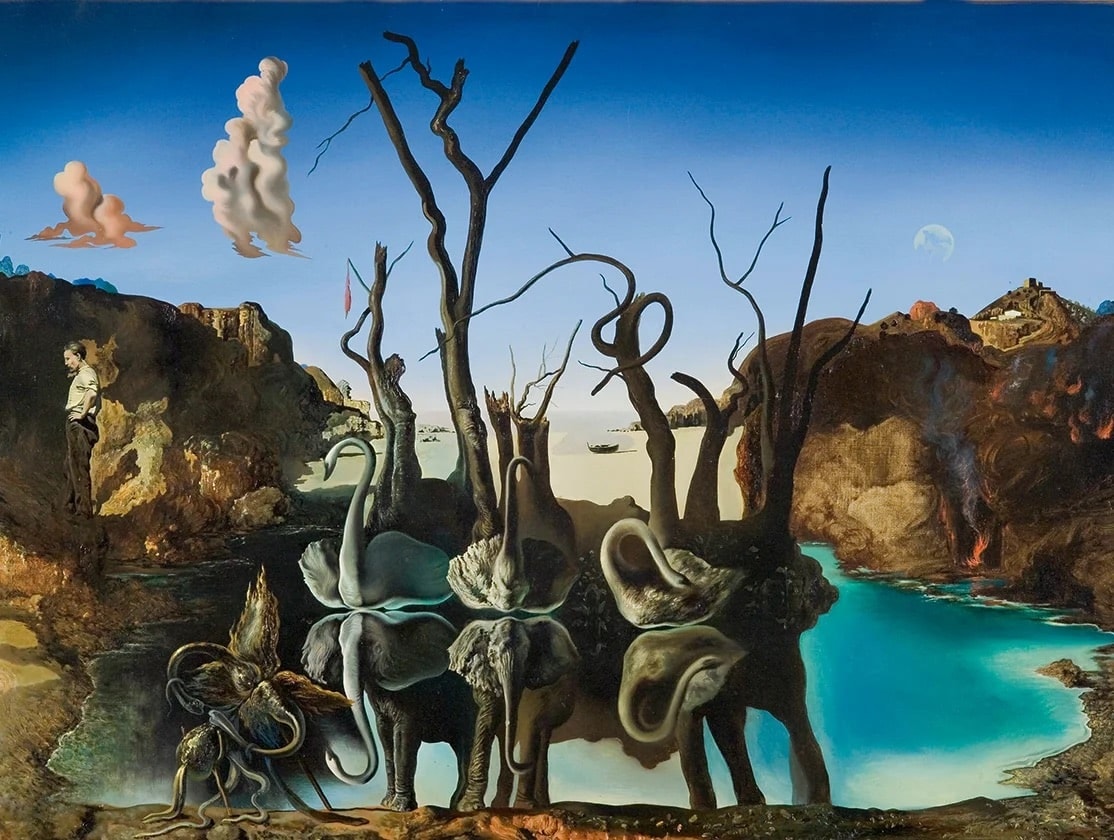
This painting is a stunning example of Dalí's use of double imagery. In the reflective waters of a lake, swans transform into elephants, their mirrored forms creating a surreal and unexpected illusion. The work explores the themes of transformation and perception, challenging viewers to see beyond the surface.
5. Dream Caused by the Flight of a Bee Around a Pomegranate a Second Before Awakening (1944)
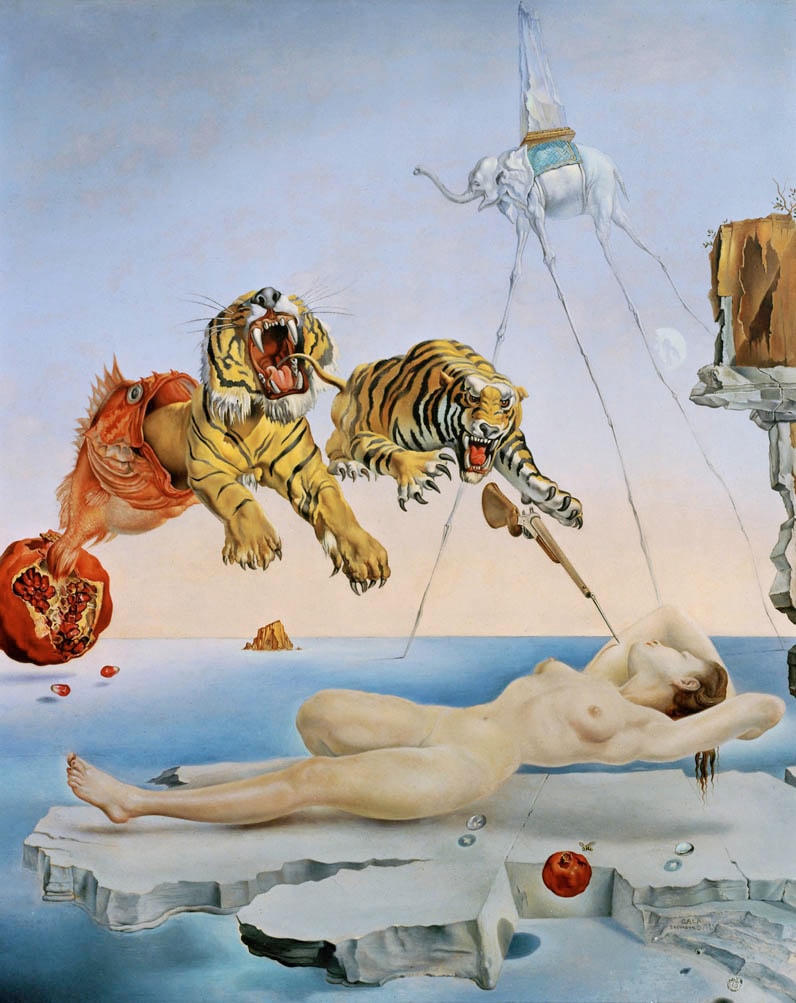
This evocative painting captures the fleeting and irrational nature of dreams. A woman levitates above a rocky shore, surrounded by surreal elements, including a pomegranate, a fish, a tiger, and a bayonet. The pomegranate symbolizes fertility and resurrection, while the imagery reflects Dalí’s fascination with Freudian theories of the unconscious. This is located in Thyssen-Bornemisza Museum, Madrid, Spai
6. Metamorphosis of Narcissus (1937)
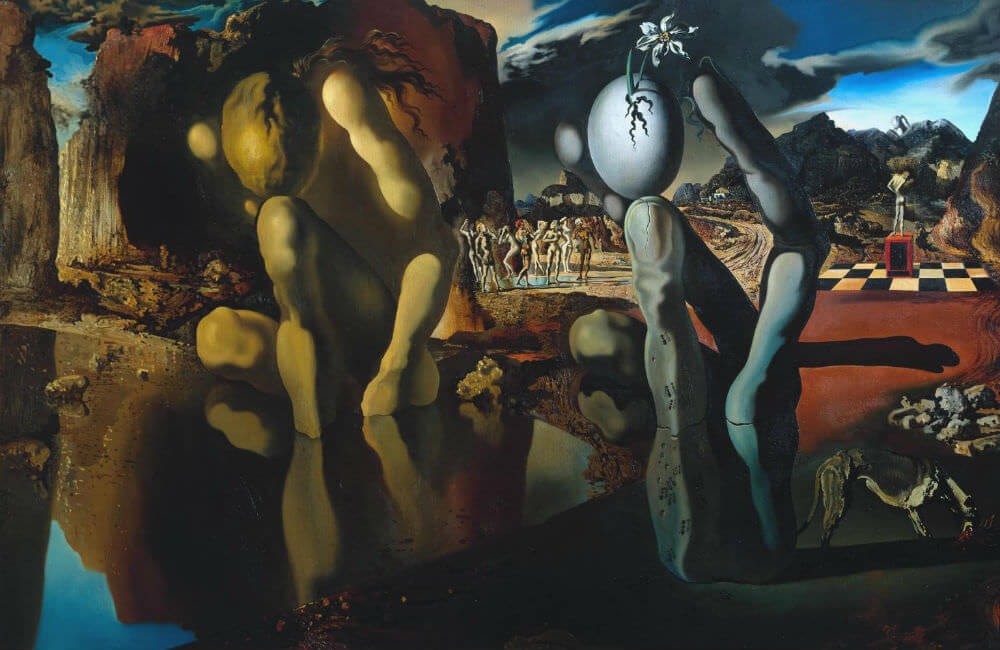
This painting reimagines the Greek myth of Narcissus. Dalí portrays a figure and its reflection transforming into a hand holding an egg, symbolizing rebirth and transformation. The sharp details and symbolic imagery show Dalí’s interest in mythology and psychology. This painting is housed in Tate Modern in London.
7. Galatea of the Spheres (1952)
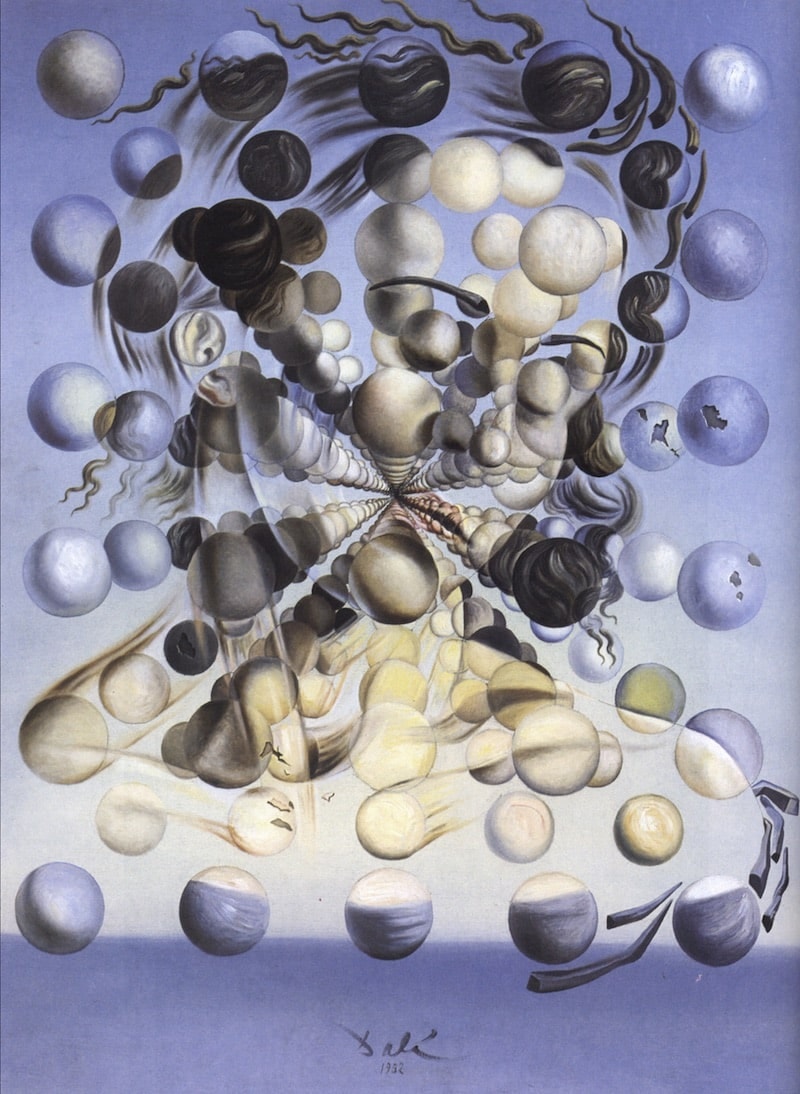
Galatea of the Spheres is a captivating portrait of his wife and muse, Gala, in a fragmented yet harmonious style. Her face is composed of floating spheres, meticulously arranged to create a three-dimensional, surreal effect. This composition reflects Dalí’s fascination with atomic theory, symbolizing the structure of matter and highlighting his post-war interest in science and spirituality. The ethereal background enhances the painting’s otherworldly quality, elevating Gala to a celestial, almost divine figure. In his "nuclear mysticism" phase, this painting shows Dalí’s love for Gala and his focus on universal themes, combining art, science, and faith. It is displayed at the Salvador Dalí Theatre-Museum in Figueres, Spain.
8. The Hallucinogenic Toreador (1969-70)
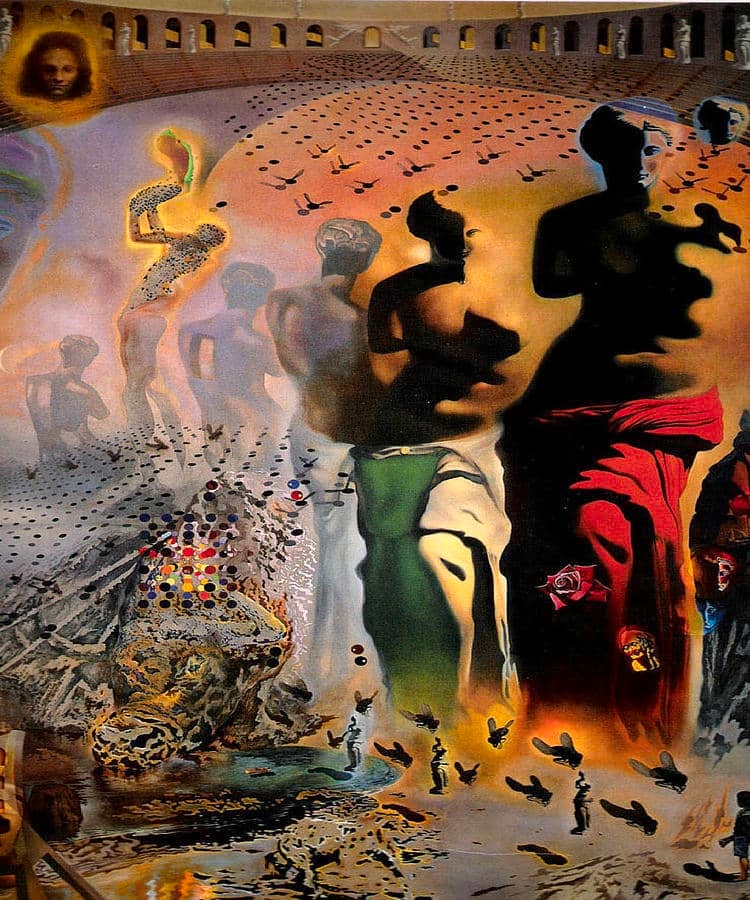
Source
Housed at the Salvador Dalí Museum in St. Petersburg, Florida, this complex work hides a bullfighter’s face within a surreal composition of Venus de Milo statues and other elements. It reflects Dalí’s Spanish heritage and explores themes of duality and memory.
9. Christ of Saint John of the Cross (1951)
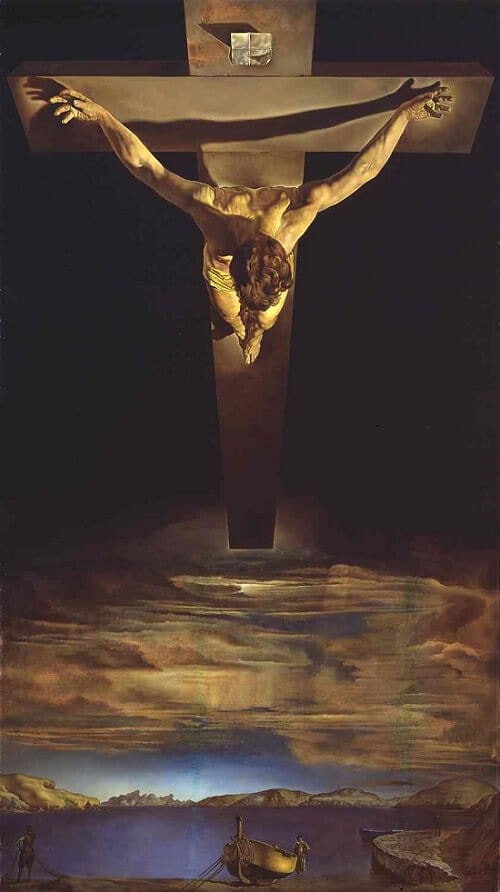
This painting, located at the Kelvingrove Art Gallery and Museum in Glasgow, Scotland, shows Christ on the cross from an aerial perspective. Dalí focuses on divinity rather than suffering, using dramatic lighting and a calm seascape to create a spiritual and uplifting atmosphere.
10. Leda Atomica (1949)
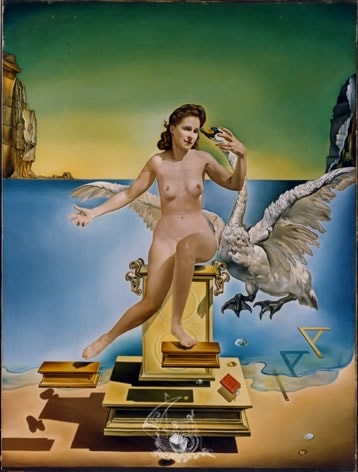
This piece reimagines the myth of Leda and the swan, symbolizing divine love and scientific discovery. The objects floating in the air reflect Dalí’s interest in atomic theory and suspension. Displayed in the Salvador Dalí Theatre-Museum in Figueres, Spain.
11. Soft Construction with Boiled Beans (Premonition of Civil War) (1936)
This painting depicts a grotesque human-like figure tearing itself apart. It symbolizes the chaos of the Spanish Civil War, with boiled beans adding a surreal and unsettling element. The sharp, exaggerated forms highlight Dalí’s skill in conveying emotional intensity. Located at the Philadelphia Museum of Art.
12. The Great Masturbator (1929)
Housed at the Museo Reina Sofía in Madrid, Spain, this painting portrays a distorted figure and surreal elements symbolizing Dalí’s personal struggles with identity and sexuality. Its vivid colors and bizarre forms reveal the artist’s exploration of the subconscious.
13. The Face of Mae West Which May Be Used as an Apartment (1935)
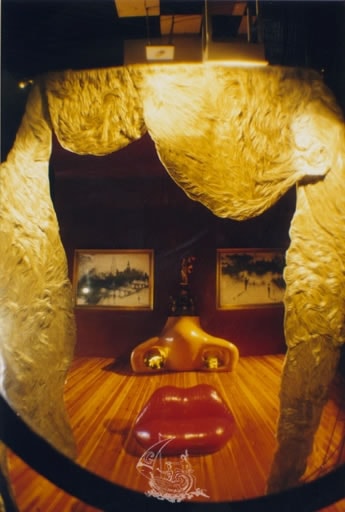
This imaginative work transforms Mae West’s face into a surreal living space. Dalí’s precise arrangement of objects showcases his playful creativity and attention to detail. Located at the Salvador Dalí Theatre-Museum in Figueres, Spain,
14. The Disintegration of the Persistence of Memory (1954)
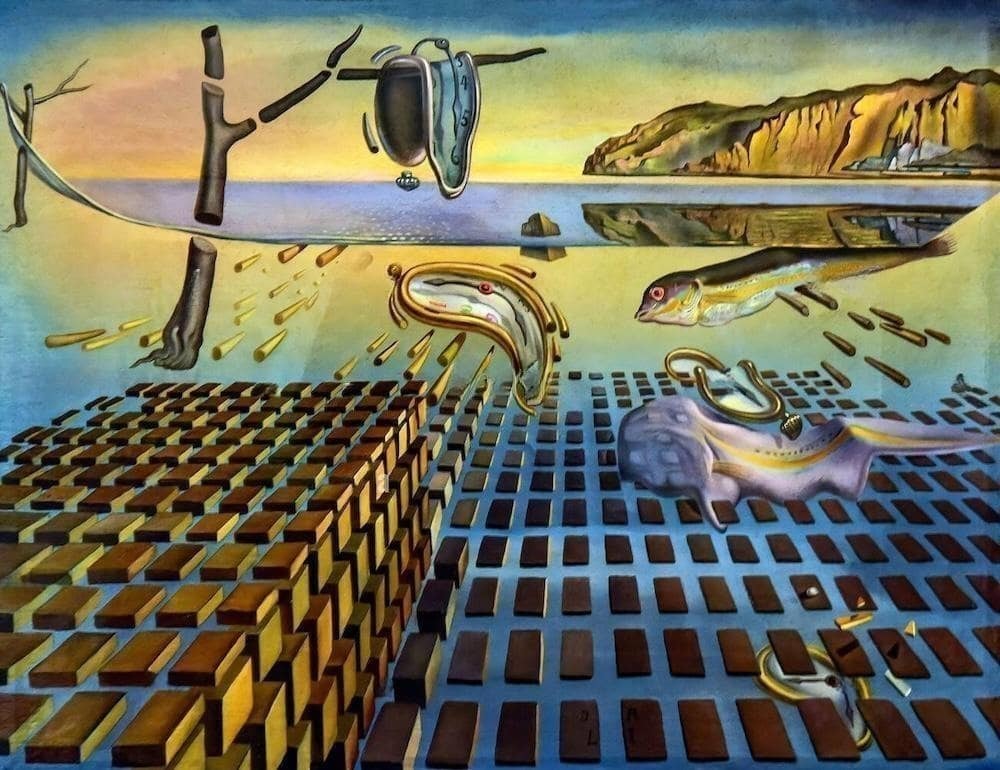
This painting reimagines his earlier masterpiece as fragmented blocks floating in a watery setting, symbolizing the scientific discoveries of the atomic age. The painting is displayed at the Salvador Dalí Museum in St. Petersburg, Florida.
15. Apparatus and Hand (1927)
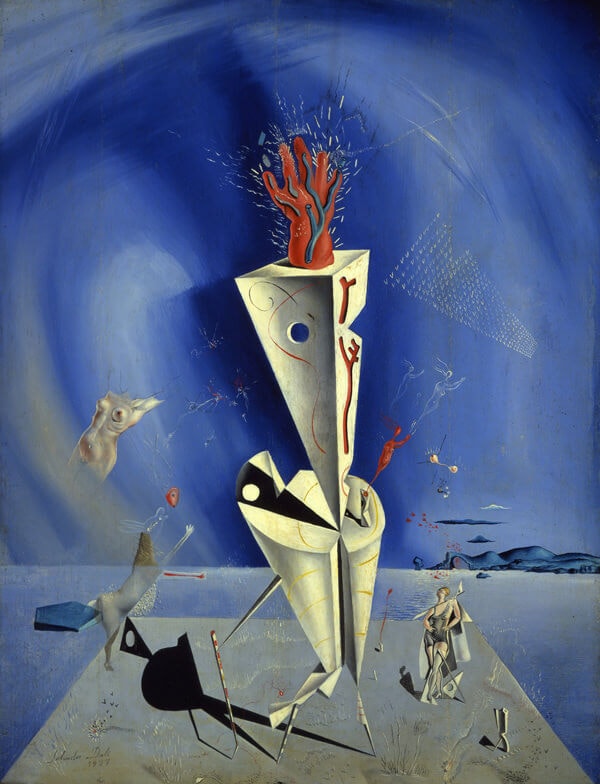
The Madonna of Port Lligat is a surreal and symbolic portrayal of religious devotion, created in two versions. Both paintings depict the Virgin Mary, modelled after Dalí’s wife Gala, holding the infant Christ, with surreal elements like open forms and symbolic objects such as shells, bread, and a cracked egg. These elements emphasize Mary’s role as a vessel for the divine and explore themes of life, resurrection, and nourishment. The 1949 version is housed in the Haggerty Museum of Art in Milwaukee, Wisconsin, while the more elaborate 1950 version remains in a private collection.
16. The Madonna of Port Lligat (1949 and 1950)
The Madonna of Port Lligat is a surreal and symbolic portrayal of religious devotion, created in two versions. Both paintings depict the Virgin Mary, modelled after Dalí’s wife Gala, holding the infant Christ, with surreal elements like open forms and symbolic objects such as shells, bread, and a cracked egg. These elements emphasize Mary’s role as a vessel for the divine and explore themes of life, resurrection, and nourishment. The 1949 version is housed in the Haggerty Museum of Art in Milwaukee, Wisconsin, while the more elaborate 1950 version remains in a private collection.
Reflecting Dalí’s return to Catholicism, the work merges traditional Christian imagery with his surrealist approach. His meticulous technique brings hyper-realistic detail to the surreal composition, creating a harmonious blend of spirituality and innovation. The Madonna of Port Lligat is celebrated as one of Dalí’s most profound explorations of faith, art, and the connection between the physical and the divine.
17. The Enigma of Desire (1929)
The Enigma of Desire is an introspective and emotionally charged painting that delves into the complexities of memory, love, and longing. The composition features a large, biomorphic structure resembling a distorted head or landscape. This form is punctuated with numerous cavities, each containing the phrase "ma mère" (my mother) written repeatedly, emphasizing Dalí’s fixation on his relationship with his late mother.
The painting reflects Dalí’s exploration of Freudian psychoanalysis, particularly the influence of childhood memories and subconscious desires. With surreal imagery and deeply personal themes, The Enigma of Desire is a powerful example of Dalí’s ability to translate internal conflicts into evocative and thought-provoking art.
18. The Sacrament of the Last Supper (1955)
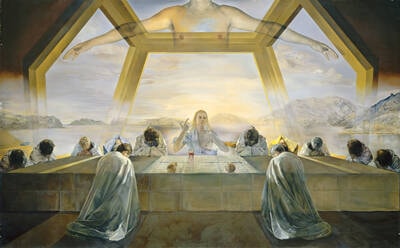
The Sacrament of the Last Supper is a striking reinterpretation of the iconic biblical scene, blending Renaissance-inspired composition with Dalí’s surrealist vision and interest in geometry. The painting depicts Christ and his apostles seated around a translucent table, positioned within a dodecahedron, a twelve-sided geometric figure symbolizing divine order.
This work reflects Dalí’s deepening spirituality during his "nuclear mysticism" phase, where he merged religious themes with scientific concepts, particularly those related to atomic theory and mathematics. The dodecahedron reinforces the connection between faith and the cosmos, symbolizing the harmonious structure of the universe. This painting is housed in the National Gallery of Art in Washington, D.C
19. Geopoliticus Child Watching the Birth of the New Man (1943)
Geopoliticus Child Watching the Birth of the New Man is a striking allegory of transformation and global rebirth during a pivotal historical era. Created during Dalí’s time in the United States, the artwork reflects his perspective on the shifting world order during World War II and the rise of America as a global power. Part of the Dalí Theatre-Museum collection in Figueres, Spain, this painting remains one of Dalí’s most profound works, exploring universal themes of growth, conflict, and renewal.
20. Woman with a Head of Roses (1935)
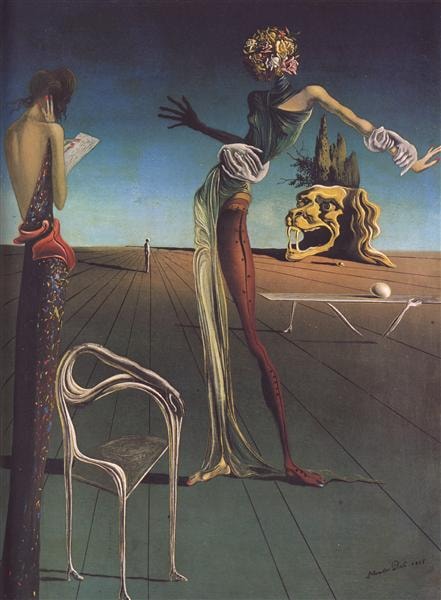
This painting features a faceless woman with a head of roses, symbolizing idealized beauty and anonymity. Its surreal imagery challenges conventional notions of identity.
The work reflects Dalí’s exploration of identity and the duality of beauty and emptiness. Created during the rise of the Surrealist movement, this painting also aligns with the movement’s themes of deconstructing traditional norms and delving into the subconscious. Dalí’s precise brushwork and use of light and shadow enhance the painting’s surreal quality, making the figure appear lifelike yet unsettling.
21. The Galacidalacidesoxiribunucleicacid (1963)
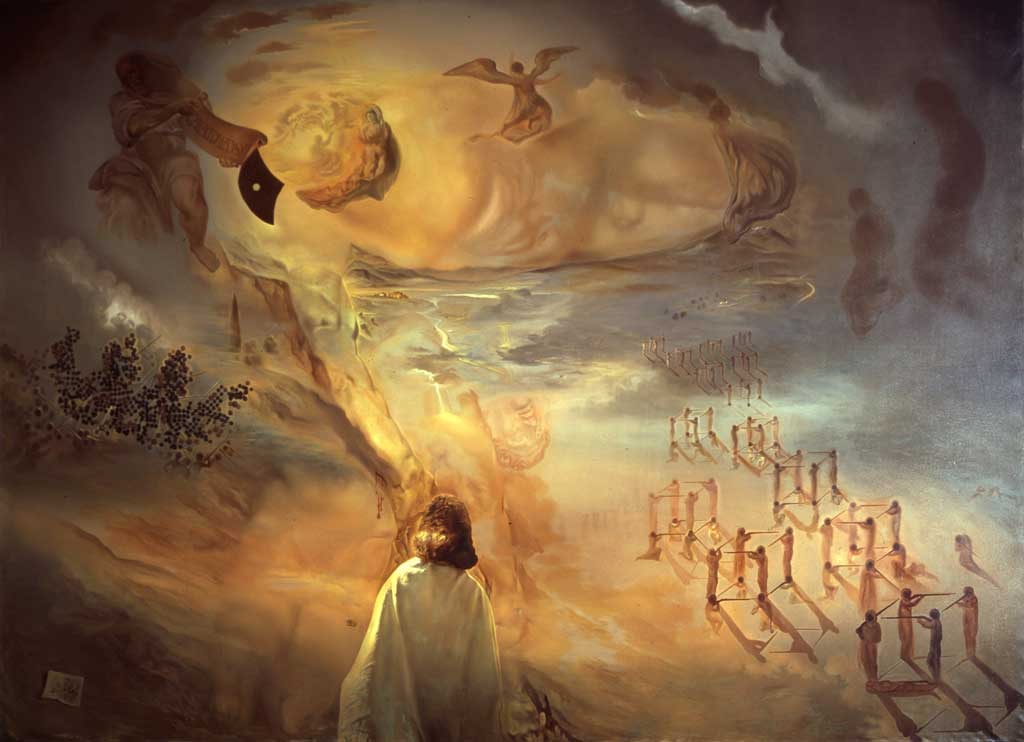
The Galacidalacidesoxiribunucleicacid is a complex and monumental painting that merges science, religion, and Dalí’s devotion to his wife, Gala. The title is a creative play on "deoxyribonucleic acid" (DNA), reflecting Dalí’s fascination with the scientific discovery of DNA’s double-helix structure. The composition features a series of fragmented, dreamlike elements: figures floating in a cosmic landscape, a central crucifix, and molecular structures that resemble DNA strands. This painting is housed in the Salvador Dalí Theatre-Museum in Figueres, Spain.
This is a testament to Dalí’s intellectual curiosity and ability to fuse disparate ideas into a cohesive and thought-provoking masterpiece. The painting is celebrated as one of Dalí’s most ambitious works, symbolizing the intersection of art, science, and spirituality.
22. The Discovery of America by Christopher Columbus (1958-1959)
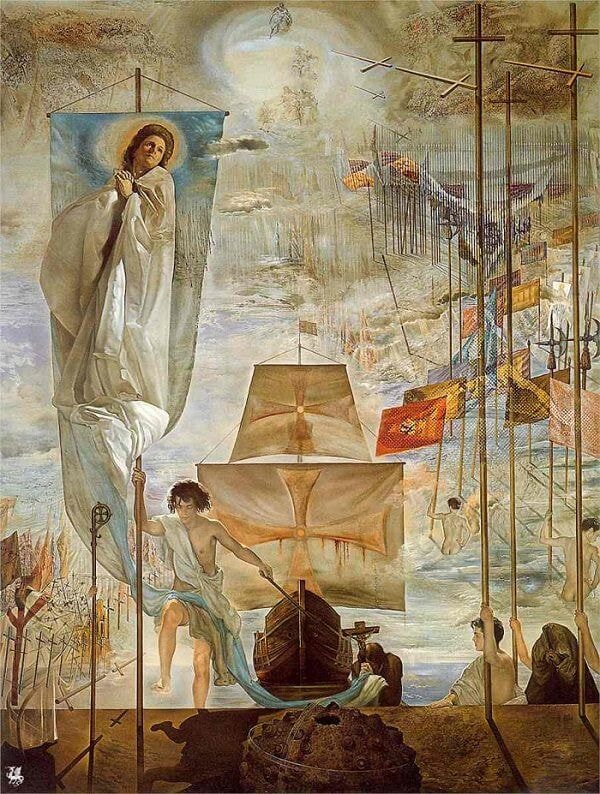
This painting is a grand and symbolic depiction of the explorer’s arrival in the New World. The massive canvas portrays Christopher Columbus, modelled after Dalí himself, carrying a flag emblazoned with the image of the Virgin Mary. Surrounding him are surreal and historical elements, including angels, religious figures, and fragmented ships. The painting is dominated by a radiant light that illuminates the central figures and the ethereal oceanic setting, creating a mystical and spiritual atmosphere.
The painting reflects Dalí’s fascination with Spain’s historical and religious heritage, as well as his devotion to Catholicism. It symbolizes not only the physical discovery of America but also the spiritual journey of exploration and faith. The inclusion of Gala as the Virgin Mary underscores her role as Dalí’s muse and a guiding presence in his life. The work of Dalí’s "nuclear mysticism," combines religious themes with precise, almost scientific detail. With its rich symbolism, dramatic composition, and intricate execution, This stands as one of Dalí’s most ambitious and celebrated works, honouring history and faith through his surrealist lens. This monumental work is housed in the Salvador Dalí Museum in St. Petersburg, Florida.
23. The Swallow’s Tail (1983)
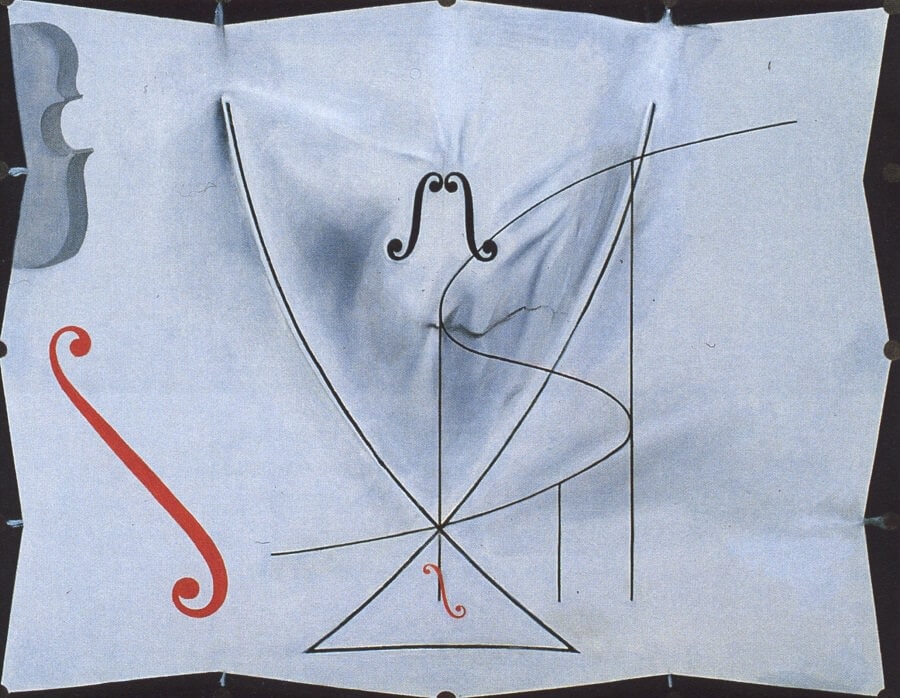
This is the final painting in his career and a culmination of his lifelong fascination with science, mathematics, and symmetry. Inspired by René Thom’s "catastrophe theory," the painting explores concepts of sudden change and instability in mathematical systems.
This painting reflects his enduring interest in the intersection of art and science. The swallow’s tail curve, a key concept in catastrophe theory, symbolizes abrupt transitions, which Dalí connects to broader themes of life, transformation, and chaos. The fragmented cello is believed to symbolize harmony disrupted, reflecting Dalí’s preoccupation with the fragility of order. This painting serves as a fitting conclusion to Dalí’s career, encapsulating his intellectual depth, technical mastery, and ability to transform complex ideas into visually striking art. The Swallow’s Tail remains a testament to Dalí’s relentless pursuit of innovation and exploration until the very end of his life. This painting is housed in the Salvador Dalí Theatre-Museum in Figueres, Spain.
24. The Enigma of Hitler (1939)
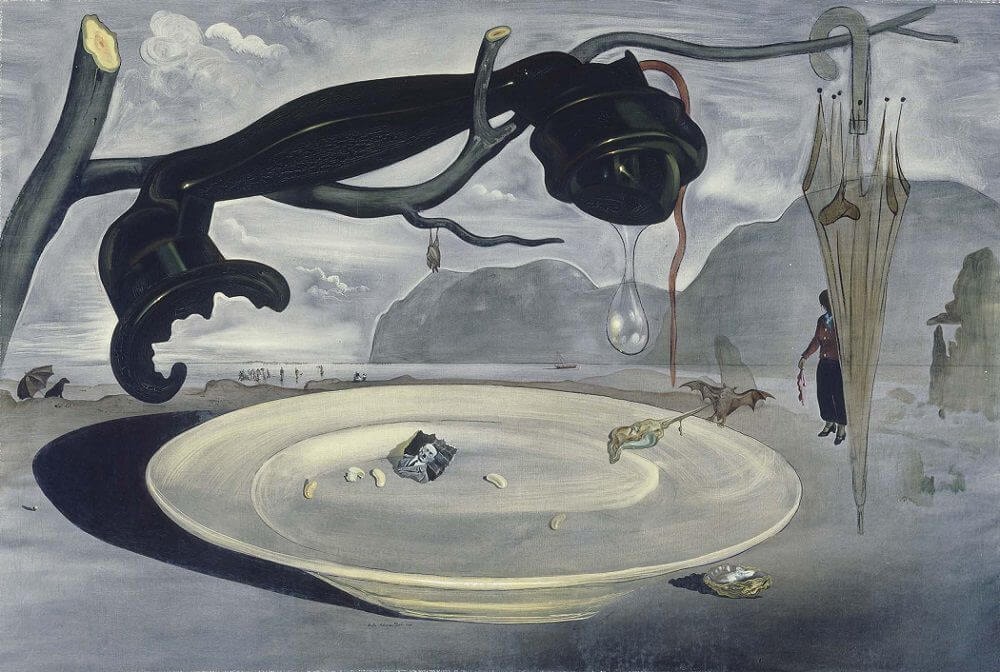
Salvador Dalí’s The Enigma of Hitler is a haunting portrayal of the tense political climate preceding World War II. Set in a barren, desolate landscape, the composition features surreal elements such as a dripping telephone, an umbrella, and other scattered objects. The telephone symbolizes broken communication and failed diplomacy, while the desolate setting conveys a sense of foreboding. At the painting’s center lies a small photograph of Adolf Hitler, underscoring the dictator’s influence on the global stage.
Dalí crafted this piece as a commentary on the anxiety and uncertainty of the era. The decaying forms and chaotic arrangement reflect the crumbling of order and the inevitability of conflict. Critics view the painting as controversial and insightful, highlighting Dalí’s ability to transform complex political tensions into symbolic and unsettling imagery. Now part of a private collection, The Enigma of Hitler remains a powerful testament to the fragility of peace.
25. The Temptation of Saint Anthony (1946)
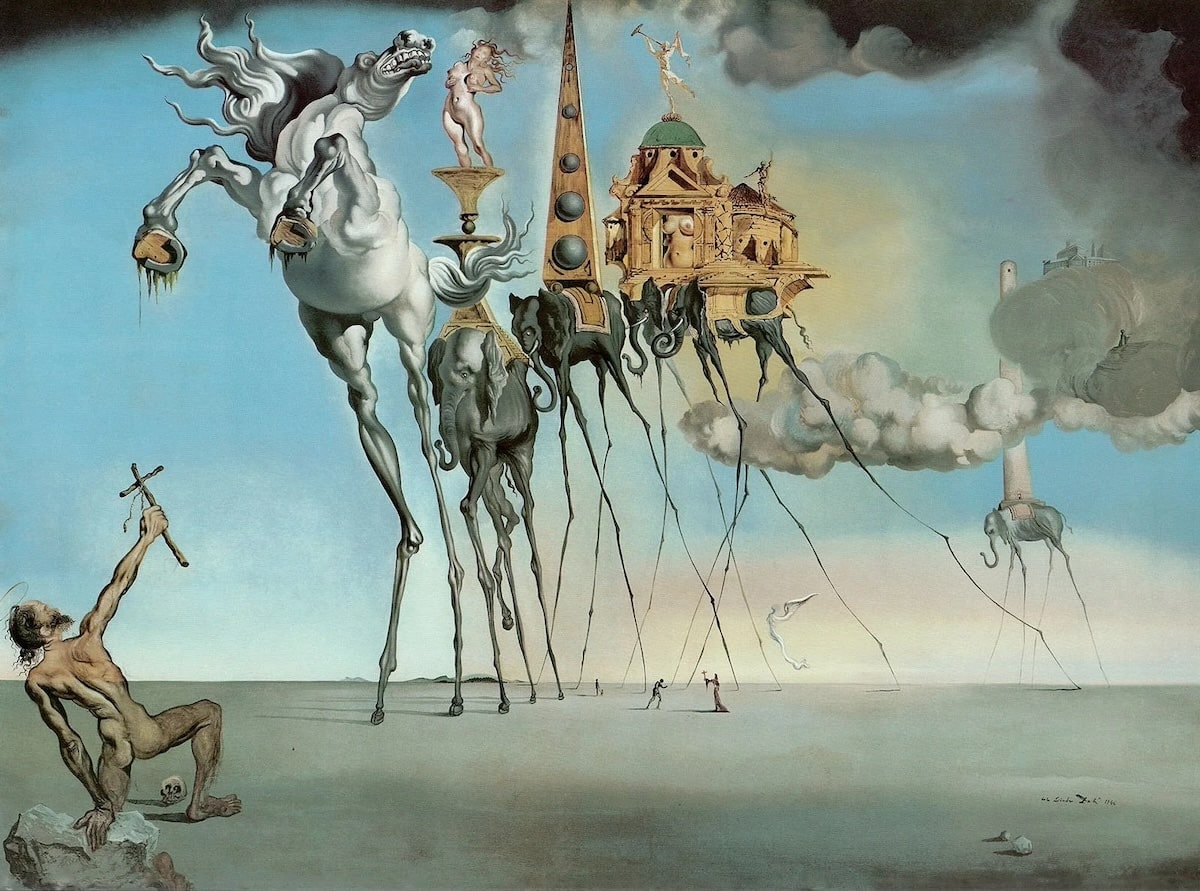
The Temptation of Saint Anthony is a striking depiction of spiritual struggle and temptation, set against a barren desert backdrop. The painting features Saint Anthony kneeling with a cross, resisting a procession of towering, spindly-legged creatures. Among these creatures are an elephant carrying a nude woman and other symbolic figures representing wealth, power, and sensuality. The otherworldly forms and desolate setting evoke vulnerability and tension. This artwork resides in the Royal Museums of Fine Arts of Belgium, Brussels.
Dalí created this piece for a contest tied to a film adaptation of The Private Affairs of Bel Ami, focusing on Saint Anthony’s temptations. While it did not win, the painting earned acclaim for its vivid imagery and profound symbolism. The towering creatures symbolize earthly desires, with their elongated, fragile legs highlighting the instability and transience of material temptations. Dalí’s masterful use of light, shadow, and meticulous detail enhances the surreal and introspective atmosphere, making the work a powerful meditation on human resilience and the conflict between spiritual purity and worldly allure.
Conclusion
Salvador Dalí’s 25 iconic paintings showcase his unmatched ability to blend surrealism, symbolism, and technical mastery, offering viewers a deep dive into themes of time, identity, spirituality, and the subconscious. From the melting clocks of The Persistence of Memory to the towering creatures in The Temptation of Saint Anthony, each piece reveals the depth of his imagination and his profound influence on the art world.
If Dalí’s surreal masterpieces have inspired you, explore our abstract art page to discover more captivating canvas art. For more insights and collections, visit MintSuper Art and immerse yourself in the world of creativity and artistic expression.

